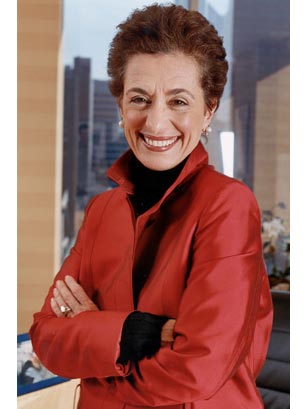
Turning Plaid Into Profits
That Rose Marie Bravo recently finished reading Jane Austen's Persuasion — a fact she announces with an impassioned "Oh!" from her sofa on the 30th floor of the New York City offices of Burberry — is fitting. She has engaged in a grand-scale persuasion of her own of late that is widely considered a retail marvel.
Since being named chief executive of the British design house seven years ago, she has convinced the style elite that the dormant, 148-year-old brand — with its placid beige plaid, which had been spotted, if it was noticed at all, lining the raincoats on markdown racks — not only is no longer a fashion anathema but is in fact a status symbol. Her feat has more than doubled the company's sales, turning it from a $470 million-a-year enterprise to a $1 billion behemoth.
"I didn't quite know until I got there what I was going to uncover," says Bravo, 53. "It didn't take long to see that underneath the debris there was this beautiful, quality heritage. Of course, part of it was that the timing was right to restore. People were interested in it." The checks are now vaunted on ball gowns, bikinis and stilettos. There are fragrance and children's lines and sexy ad campaigns featuring chic Brits Kate Moss and Stella Tennant. The iconic trench coat, first designed in 1901 by Thomas Burberry as an army officer's raincoat, today comes in a panoply of styles, colors and prints, including this season's floral.
She dubs the transformation "doing what Gucci did, at Burberry," but Bravo was displaying corporation-altering prescience and chutzpah long before Tom Ford made them fashionable. As president of Saks in the '90s, she brought labels like Gucci, Jil Sander and Prada onto the selling floor, a move that began the store's return to the luxury league of Neiman Marcus and Bergdorf Goodman. As a cosmetics buyer at Macy's in the early '80s, Bravo noted the sudden proliferation of fuchsia in fashion. She called Carol Phillips, co-founder and then head of Clinique. "I said, 'This pink is wildly popular. It's everywhere in the clothing. We don't have a lipstick that color,'" Bravo recalls. Phillips called back to say a new lipstick would be in the line immediately. Bravo says her biggest break came in 1988 when Macy's promoted her from senior vice president of merchandising to chairman and chief executive of its new acquisition, the California-based chain I. Magnin.
If part of her intrepidity comes from growing up the daughter of a hairdresser who owned a salon in New York City's Bronx — Bravo attended the elite public Bronx High School of Science and Fordham University, also in the Bronx — the rest may result from the fact that early in her career, she saw "women in action." Says Bravo: "In cosmetics, which is where I particularly grew up, we had these wonderful role models. Estée Lauder, Helena Rubinstein and Elizabeth Arden are all women who created companies." Clinique's Phillips "hired all women," Bravo says. "Her top lieutenants were female. If you've been given this road map and you see that others have gone before you and achieved, you never have in your mind the notion of failure. You have the notion that you can do it too, if you're good enough and smart enough and make the right decisions."